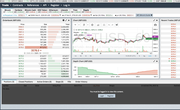/latest/2019/01/bitmex-its-auto-deleveraging-system-and-the-growing-size-of-its-insurance-fund/
This article takes a look at crypto derivatives exchange BitMEX’s Auto-Deleveraging (ADL) system and the growing size of its Insurance Fund (in BTC), which is used to avoid auto-deleveraging its users’ positions.
BitMEX “offers a variety of contract types,”all of which “are bought and paid out in Bitcoin.” BitMEX currently futures products for Bitcoin (XBT), Cardano (ADA), Bitcoin Cash (BCH), EOS, Ether (ETH), Litecoin (LTC), Tron (TRX), and XRP.
According to BitMEX, here is how its Auto-Deleveraging (ADL) system works:
“When a trader’s position is liquidated, the position is taken over by the BitMEX liquidation engine. If the liquidation cannot be filled by the time the mark price reaches the bankruptcy price, the ADL system automatically deleverages opposing traders’ positions by profit and leverage priority. The price at which a traders’ positions are closed out is the bankruptcy price of the initial liquidated order.”
Futures trading platforms generally use one of two methods for forced liquidation risk management:
- socialized loss
- automatic counterparty delveraging
BitMEX says that it uses the ADL system “as a margining method for its speculative derivative instruments as an evolution to the ‘Socialised Loss’ system,” and listing the following as the main two problems with socialized loss systems:
- “A single risky trader can create a large loss for all traders, including low-risk traders.”
- “Profit must be locked until rebalance or settlement in case of loss.”
BitmEX says its ADL system “aims to resolve loss uncertainty, allowing traders to make decisions as soon as the deleveraging event occurs, rather than wait for rebalance or settlement,” and that traders “who become deleveraged will be immediately informed of their closeout price and size” (of course, such traders could then “choose to re-enter the market”).
BitMEX has an Insurance Fund, which is used “to avoid Auto-Deleveraging in traders’ positions.” This fund “is used to aggress unfilled liquidation orders before they are taken over by the auto-deleveraging system.” BitMEX’s Insurance Fund, which “grows from liquidations that were able to be executed in the market at a price better than the bankruptcy price of that particular position”, as of January 26th, has a balance of 21,397 BTC. In the words of Sludgefeed’s report on this insurance fund, “as more traders get rekt, the larger this fund grows.
As Messari crypto analyst Zack Voell astutely observed recently, as Bitcoin’s price kept declining in 2018, the size of the BitMEX Insurance Fund (in bitcoins) kept growing:
Size of BitMEX’s Insurance Fund:
01 Jan 2016: 0 BTC
01 Jan 2017: 162 BTC
01 Jan 2018: 2,720 BTC
01 Jan 2019: 20,776 BTCNow look at this. pic.twitter.com/EUdJJ5tcAf
— Zack Voell (@zackvoell) January 22, 2019
And here is another interesting observation from Voell:
Also, BitMEX’s Insurance Fund growth (an unbeatable benchmark) is roughly as predictable as Bitcoin’s monetary policy. pic.twitter.com/kcZ9cTGX5c
— Zack Voell (@zackvoell) January 22, 2019
Featured Image Courtesy of BitMEX







